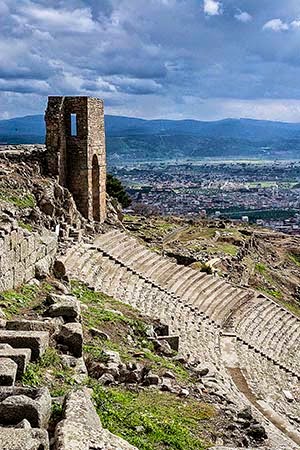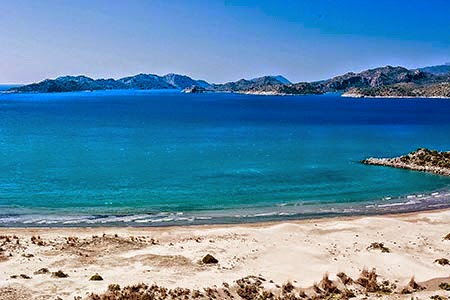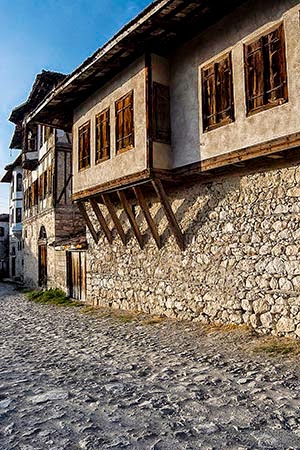Istanbul Archaeology Museums
Be sure to see at least the classical sculpture, the incredible tiles and pottery from the city of Iznik, and the Ishtar Gate. Below are just a few examples that will expand your knowledge about ancient times, show just how interrelated our cultures are, and hopefully amaze you about things we take for granted today.
Day 3 PM: In particular be sure to see at least the ground floor of the Archaeological Museum (main building). Second see the incredible tiles from the city of Iznik in the Museum of Islamic Art (also known as Tiled Kiosk). By the way, the English work kiosk comes from Turkish word köşk (pavilion). Finally go to the Museum of the Ancient Orient to at least see the treasure from ancient Babylon. Note that these are three separate museums but right next to each other. The museum is open 9:00 to 17:00 h but closed Mondays. There are so many interesting artifacts to see that an afternoon was barely enough time. As with any museum, trying to see everything without learning more about specific artefacts can be overwhelming and you will get "museumed out".
Archaeological Museum
Alexander Sarcophagus
The Alexander Sarcophagus, found in Sidon (Lebanon), is one of the most important artifacts in the museum. No Alexander the Great was not buried in here! It is so named because it portrays him fighting at the Battle of Issus where Alexander defeated the Persians in 333 BC.
Alexander is shown on his horse, preparing to thrust a spear at the Persian cavalry. Greek and Persian soldiers can easily be distinguished. Persians, Turks and other Central Asians who lived a horse-riding culture wore trousers. Greeks, due to their hotter climate, wore short tunics.
Please note the remnants of red paint on the left side. One of the most surprising things about the Classical Period is that the marble, which we consider beautiful on its own, was covered in bright paint colours. Look at the painted model along the wall. This applies to all the famous classical sculptures seen in museums everywhere and not just those here in Turkey. So keep that in mind next time your are in Athens or Rome.
 |
| Greek Geometric Borders |
Today we all wear pants because the nomadic horse-riding tribes from Central Asia – which includes the Turks ‒ brought that custom west with them.
Similarly, the sarcophagus is a combination of Greek-style bas-relief and motifs (such as the never-ending lines and egg-and-dart motif at the bottom of the photo) and Eastern art (such as the swastika, which was an ancient symbol throughout the East for auspiciousness).
Alexander's Bust
Alexander the Great was one of the first rulers to understand and exploit coins, portraits and sculpture for their propaganda value. Coins were first introduced around the 7th century BC by the Lydians (western Turkey)! After Alexander all rulers minted coins with their face profile on the “heads” side and some propaganda symbol of the state on the tails side. Similarly his statues were made to look god-like. Alexander adopted the Asian idea of honouring rulers as if they were gods. So statues showed characteristics that had been used to represent gods and heroes: hair like a lion's mane, the face of an idealized youth...
Alexander sought to hybridize Greek and Persian culture and homogenize the populations of Asia and Europe. Of particular historical importance is that Anatolia (Turkey) became a Greek colony. The bust of Alexander the Great (2nd century BC) was found in Pergamum (Bergama), Turkey. Alexander brought Greek artisans and culture with him. So we can be reasonably sure that this bust was carved by his sole sculptor, Lysippus, who was considered one of the three greatest sculptors of the Classical Greek era.
The sculptors imported to Gandhara (Gandahar, Afghanistan) had an even more significant impact on Asia. Greek sculptors created the first sculptures (with togas and Greek faces) of Buddha, who had explicitly forbade images. Now there are sculptures of Buddha all over the world.
Silk Routes
The Hellenistic Empire led to increased contact between East and West and thus increased desire for trade. This led to the Silk Routes (it was not one road; it was sometimes by ocean) and the impact of ideas and inventions, arts and science on both east and west that we now take for granted
─ think paper, toilet paper, paper currency, printing, porcelain, silk, foods, spices, compass, gunpowder, and the Black Death plague to name just a few.
─ think paper, toilet paper, paper currency, printing, porcelain, silk, foods, spices, compass, gunpowder, and the Black Death plague to name just a few.
Sarcophagus of the Crying Women
The Sarcophagus of the Crying Women, found in Sidon (Lebanon), is an example of Hellenization of west Asia. The Sarcophagus represents an Ionian temple; note the columns. The crying women were a common funerary motif in the Middle Eastern countries.
This is the tomb of Abdalonymus who was born in
the royal family but fell on hard times and was working as a gardener in 332
BC. He was made king of Sidon by
Alexander the Great, as the previous king died in battle with Alexander.
Tiled Kiosk – Çinili Köşk
The Tiled Kiosk (1472) is one of the oldest structures in Istanbul but it is not Ottoman architecture. The polygonal pillars of the façade are typical of Persian architecture. It was a part of the Topkapı Palace outer gardens.
 Iznik Mosque Lamp
Iznik Mosque Lamp
The workshops of İznik developed a type of white ware that they painted with cobalt blue and sealed with a colourless lead glaze. Turquoise and coral colours were added to later pottery. They combined traditional Ottoman arabesque patterns with Chinese motifs.
There was a tradition of hanging pottery lamps in mosques. The opaque pottery lamps were more for decoration than for lighting. The lamps are decorated with geometric motifs, large rosettes and stylized lotus blossoms.
There are 10,000 pieces Chinese porcelain in the Topkapi Palace but almost no İznik pottery!

Tile Mihrab
Why is the Blue Mosque blue? It is decorated with thousands of blue tiles from Iznik. But why did they make blue and white tiles?
The Ottoman court liked the blue and white porcelain from China. Blame it on the Silk Routes! From the 9th century onwards, Islamic merchants started to import Chinese ceramics, which were the prime export of the Indian Ocean Silk sea route. Of course, no one else knew how to make porcelain at that time.
This tile mihrab was made using this colourful glazing technique. The tiles are ornamented with herbal and geometric figures.
 Fountain of Youth
Fountain of Youth

Imagine a room covered with rich gold, dark blue and turquoise tiles as seen in the photo on the left. It takes your breathe away.
Then at the end of the room is a fountain built in the year 1590. There is a figure of a peacock in the middle of herbal motifs. The ornaments are hand-carved and gilded. Now that is ornate!
Museum of the Ancient Orient
Ishtar Gate
The Ishtar gate was part of one of the seven wonders of the ancient world, Babylon!
Babylon was dedicated to Ishtar, the Babylonian goddess of goddess of fertility, love and war -- all the important things. Ishtar Gate was constructed in 575 BC under Nebuchadnezzar II using glazed brick with alternating rows of bas-relief.
Babylon was dedicated to Ishtar, the Babylonian goddess of goddess of fertility, love and war -- all the important things. Ishtar Gate was constructed in 575 BC under Nebuchadnezzar II using glazed brick with alternating rows of bas-relief.
Leading to the gate was a glazed tile wall, the Processional Way for major celebrations like the New Years Festival. This fragment is decorated with Lions and flowers. Why lions? The lion was the animal associated with goddess Ishtar and symbolized her protection of the street. Its repeated design served as a guide for the ritual processions from the city to the temple.
The glazes were made by pigments were blended with melted silica. Blue was a rare natural colour in the Mesopotamia. Some web sites say that the bricks are glazed with lapus lazili. This is an expensive turquoise stone even back then, so this is extremely unlikely.
What is amazing is how saturated the colour of the glazed bricks are considering they are 2500 years old. You look in disbelief thinking are these real?
What is amazing is how saturated the colour of the glazed bricks are considering they are 2500 years old. You look in disbelief thinking are these real?
Last Post: Hagia Sophia Dome-ination (Day 3 AM)
Next Post: Gulhane Park (Day 3 PM)












No comments:
Post a Comment
Please add your comments or questions